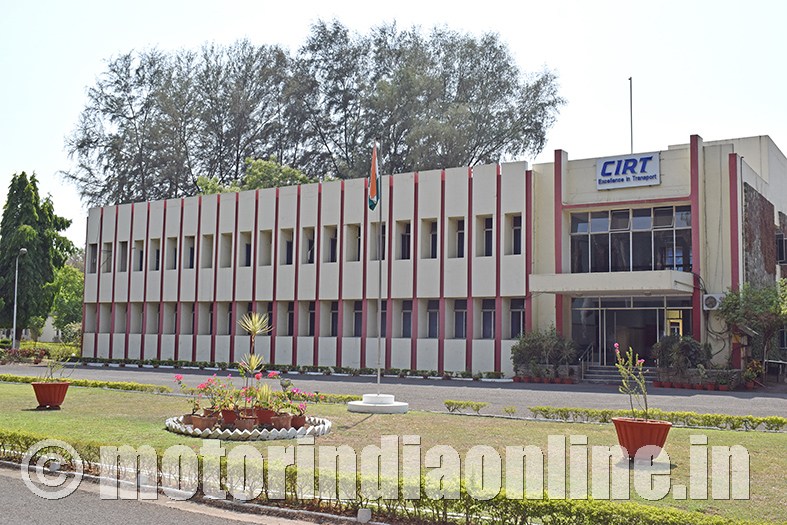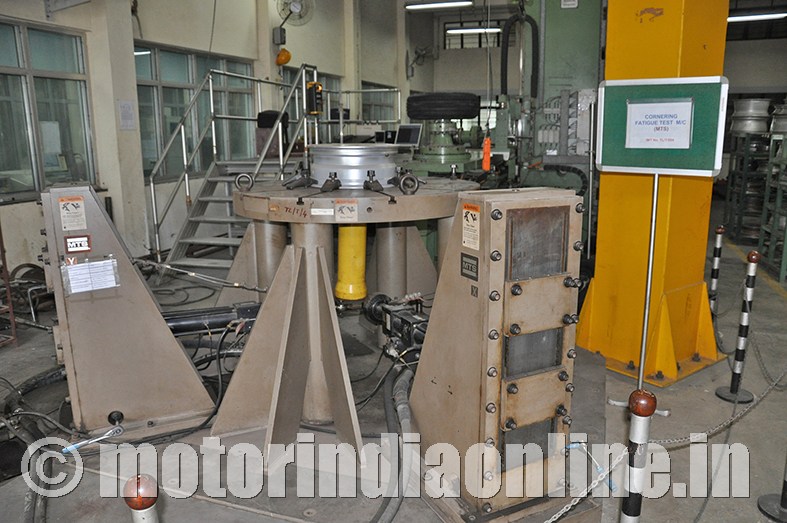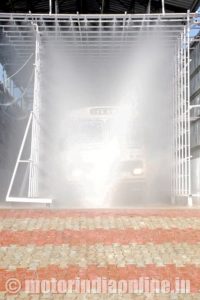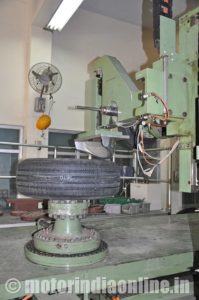Move aimed at ensuring passenger safety & job prospects for thousands
The Central Institute of Road Transport (CIRT), headquartered in Pune, offers a host of services such as technical training, consultancy and automobile component testing for stakeholders in the automotive and transport sectors. MOTORINDIA got a chance to interact with Capt. (Dr.) Rajendra B. Saner-Patil, Director, CIRT, and Mr. S. N. Dhole, Scientist – Safety and Homologation Division, CIRT, a specialist for vehicle testing & safety critical auto components. Both Dr. Saner-Patil and Shri S N Dhole come with thorough knowledge of the CMVR provisions and the Automotive Industry Standards (AIS) and has worked on interpretation of rules and codes which are prerequisite in field appraisal works like third party inspection of buses (CNG & diesel) for STUs and vehicle manufacturers, as well as audit for private and STUs bus body builders workshop and issue of accreditation certificates. Further, under their supervision, CIRT has also been carrying out type approval certification (TAC) and conformation of production (CoP) for vehicles and safety critical components.
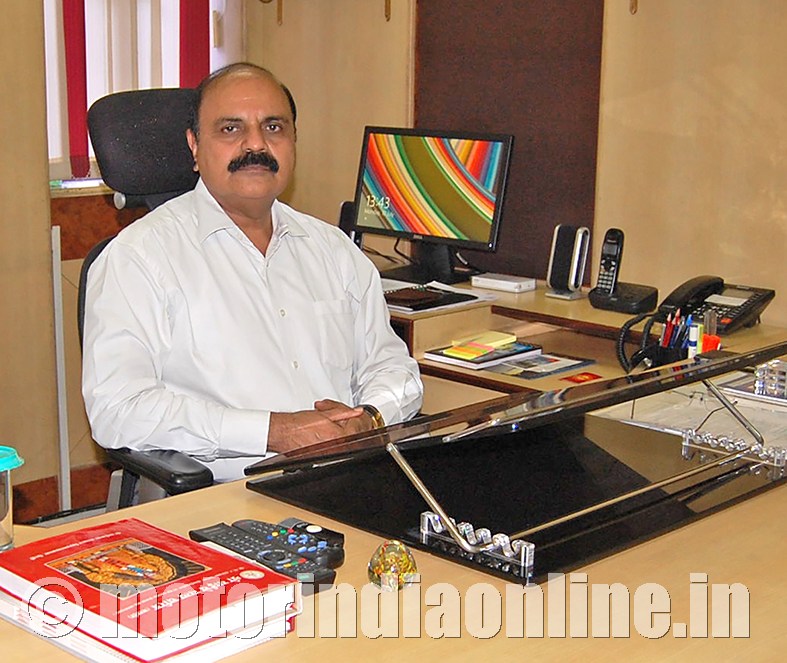
We bring you excerpts from an exclusive free-wheeling interaction with the two CIRT veterans:
Can you start by telling us about the role of CIRT in the Indian transport sector?
Dr. Saner-Patil: The Central Institute of Road Transport (CIRT) is formed by the then Ministry of Shipping & Road Transport, Govt of India (presently MoRTH) and Association of State Road Transport Undertaking (ASRTU). With five decades of experience, CIRT has emerged as a single window premier institute for the transport sector as a whole and also as a ‘Center of Excellence’ in Automotive Testing, Certification, Research, Consultancy & Training.
Since its inception, our Research & Consultancy Centre has handled several consultancy assignments in the areas of public transport planning & management, intelligent transport systems (ITS), depot computerization, computerized driving test facility, human resource management, organization restructuring, bid process management, project management consultancy, preparation of DPR for purchase of buses under JnNURM scheme, modernization of infrastructure, maintenance management, alternate fuels, vehicular emissions, stores & materials management and road safety. CIRT is also an Evaluating & Monitoring Agency of MoRTH on several projects related to public transport, ITS and road safety.
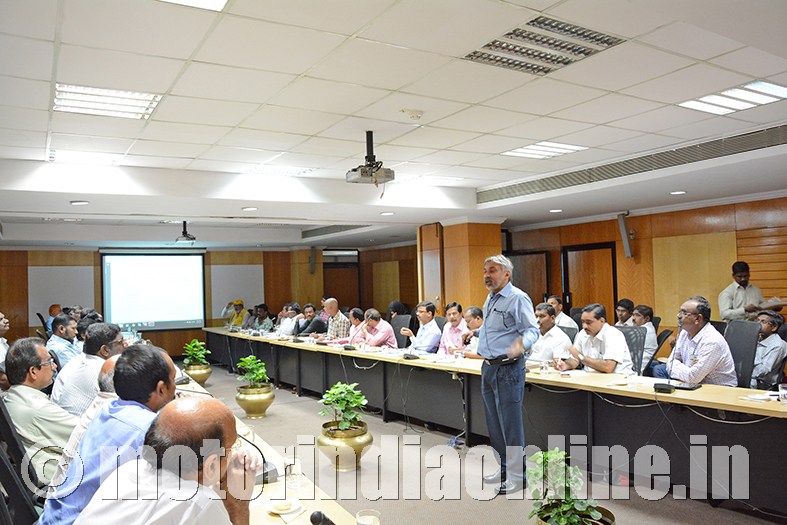
The Management Development Centre (MDC) of CIRT is regarded as a leading and the only Training Centre offering technical training programmes for the all officials of transport sector. The programmes are designed to build capacity of in-service officers in order to update the knowledge on the latest rules, regulations & amendments. Further to meet the specific needs of clients, the MDC also conducts foundation courses for newly recruited officers, advanced training programmes and in-situ programmes. In addition, MDC conducts International programmes including members of SAARC Countries, for accelerating growth in transport sector in the areas of common interest vis-à-vis mutual exchange of experience & knowledge of management practices implemented at different levels.
CIRT has a state-of-the-art test facility for carrying out component testing. The institute carries out testing of automobile components and materials as per ASRTU specifications, Automotive Industry Standards, other prevalent standards and also customized test specifications. We advise STUs on the incoming materials right from washers to crankshafts. Anything related to buses is advised by CIRT. The Ministry of Road Transport & Highways, Government of India has approved CIRT under Central Motor Vehicle Rules (CMVR 124) for certification of safety critical components and (CMVR 126) for certification of vehicles.
How did CIRT become a nodal agency for implementation of codes and standards for trucks and buses?
Dr. Saner-Patil: As informed earlier, anything related to buses is advised by CIRT and we have formulated about 450 specifications by reverse engineering for the betterment of STUs and small-scale industries. CIRT was registered under the CMV Rule 124 to carry testing of safety critical components like glass, fuel tank, plywood, light & light signaling devices, tyres, wheel rim, horn etc.
In 2007, under GSR 276 E, CIRT got the opportunity to start vehicle certification and is considered as a revolutionary initiative under which we have established a Safety & Homologation Division. The Safety & Homologation Division has played a major role in the formulation of Bus Body Code, Bus Body Builders Accreditation Systems for MoRT&H, and preparation of urban bus specification for MoUD.
The division is actively involved in certifying buses and carrying out third party inspection of buses. Till date, the division has carried out third party inspection of more than 5,000 STUs buses and about 8,000 buses of various leading vehicle manufacturers. The division has audited several bus body builders including STU bus body building workshop and issued accreditation certificates.
CIRT has also certified vehicles right from e-rickshaws to HCVs. Some of the recent projects under the ‘Make in India’ initiative include testing & certification of tarmac buses. CIRT is also involved in MoRTH piolet project for conversion of diesel bus to retrofitted electric bus.
We focus on public transport as we are interested in public safety rather than doing business. We work directly under the Ministry of Road Transport and Highways. Other than testing, we are also providing valuable inputs to the MoRTH as and when required on matters related to vehicles & passenger safety.
What are the recent codes that CIRT has issued notification on or is working for?
Dr. Saner-Patil: Across the world, as on date, no country has a code for design of sleeper coach for buses. We are proud to inform that India has pioneered in finalizing the code for design of sleeper coach buses, even before European Code (EC). ‘We have done it’ and are very happy about it.
A majority of sleeper coaches that are plying on roads in India are designed as per the customer’s specification and thereby compromising with safety norms without clear guidelines in CMVR. With the notification of the sleeper coach code AIS 119, there is clarity and standardization with respect to safety and comfort.
How did you find the need to have a sleeper coach code? Could you elaborate on it please?
Mr. S.N. Dhole: ‘It is a need of the hour’ and demand of the operators. Sleeper coaches are in great demand and manufacturing sleeper coaches is a growing business. Sleeper coaches are most suited for long-distance/overnight travel. What we have emphasized in the sleeper coach standard is safety with the provision of minimum of four emergency exits, out of which one must be a door. Two roof hatches have been made mandatory, and the fourth can either be a door or a window. This option is given to the designer or the coach builder. In the case of AC buses, roof hatches can be used as a ventilator if there is an AC failure, it is easy to access roof hatches from the upper berths. Apart from the operators even the MoRTH was hastening the implementation of these standards.
How are you taking care of all necessary safety precautions?
Mr. Dhole: The sleeper coach code also includes stability and roll-over tests, in which the stability angle should be 28 degrees minimum since buses pass through different terrains. Then there are clauses of active and passive safety. The stability test takes care of the active safety while the roll-over test takes care of the passive safety system. We are very strict about these two tests. There are norms even for passenger restrain. While he or she is sleeping, there should be some arrangement to see that passengers do not fall from the berth. Further, we have given the discretion to the coach builders to ensure that 60 per cent of the passenger berth should be covered with rails / suitable restrain system.
Even thickness of the cushion and fire retardancy have been covered in it. Since the coach and body builders are very creative by nature they have positively accepted the safety requirements in the standards / codes. They have the experience to build buses and coaches, and we are only bringing them within the framework of the CMVR rules. We have always been listening to their creative inputs. We welcome all suggestions to enhance passenger safety.
How frequent are the amendments or suggestions made and how do you ensure their implementation?
Dr. Saner-Patil: Whenever there are some modifications to the standards, it is first made available on the ARAI website and suggestions / objections are invited. If no comments are received, then amendments are made and we give sufficient time for implementation. If it is a technical change the time may range from one month to six months so that there is no objection from any stakeholder. We work in ‘sync’ with all stakeholders. Even RTOs are on our panels. They are the ones who ensure implementation of these standards and rules. We also take lectures for them and help them to understand the type approval certificates, mandatory requirements, etc.
When is the sleeper coach code going to come into effect?
Dr. Saner-Patil: It is implemented from April 1, 2017. Any sleeper coach which is built and offered for registration must follow the new codes. The Government is proactive and eager to implement the changes speedily. Hence even CIRT is very positive in its approach. The whole approach benefits the society.
Can you share details of some of the other codes that have come in?
Mr. Dhole: As informed earlier, we have also worked on the School Bus Code. We have even written to MoRTH as it is a very sensitive issue. School buses that are plying on roads are not meeting the AIS 063 standard. There are some provisions exclusively for school buses like the first step height shall be such that a child should be able to climb it comfortably, retracting type doors for clear space for entry & exit, a buzzer or alarm to warn if the door opens (accidentally), seat material should be soft, so that if emergency brakes are applied, students should not collide hard against seats etc.
In what other segments, apart from buses, do you see CIRT playing an important role?
Mr. Dhole: We have recently certified e-rickshaws. We are exploring some of the safety features like brake test. E-rickshaws are certified under GSR 709, the new standard. A lot of safety measures have been added to safeguard the battery and brakes. We do not want to compromise on occupant safety.
We also do third party inspections. The proto buses are inspected in three stages – structural, panelling and fully built. So far CIRT has carried out third party inspection of over 8,000 buses (diesel & CNG) for different STUs & OEMs. As mentioned in the beginning, CIRT also plays a role in procurement of buses and guides STUs in drafting their tender technical specifications.
What is the status of camera-based driving license tests?
Dr. Saner-Patil: The results are encouraging. Up to 65 per cent people qualify. As soon as the candidate gets out of vehicle he/she gets an indicative signal – green for pass and red for fail. Even a video recording is there. Hence it is a reliable mechanism. No manual intervention is there in the driving test and due to this the efficiency has improved.
You may agree with the fact that such initiatives are in vain without building capacity of transport officials. What are the plans for the same?
Dr. Saner-Patil: For building capacity, CIRT conducts several training programmes, conference, seminars to promote the initiative of Ministry and public transport safety at large. CIRT is the only institute in India offering 90days induction training programme for Transport department and 45days induction training programme for State Transport Undertaking officials. In addition, we have also conducted orientation training programme for upgrading the knowledge on latest technology, rules & regulations. For the Ministry, we have been conducting several training programmes on various topics like on CMVR rules, the Bus Body Code, IT in transport, Road Safety Management etc. We strive our level best to ensure maximum officials attend the training sessions. The stake holder officials from Motor Vehicle Department, Police Department, STUs and municipal corporations participate in these training programmes. We expect the officials to have the updated knowledge of safety-related features like ABS, air bag, speed limiting device, etc. In continuation, on the request of Ministry, we also conduct special conferences and seminars for OEMs to promote the safety initiatives of MoRTH.
Would you be able to spell out some of the new norms that we can expect in the next two or three years?
Mr. Dhole: Crash test norms along with electronic stability control will become mandatory for cars. ABS will become mandatory for motorcycles from April 2018. The standard for the trailer code AIS:113 is under implementation.
From October 2015, no vehicle of M2, M3 & N3 category without ABS will be registered and the same will be applicable to trailers also. We are also pondering over-dimensions of car carrier and because of that we are thinking to have cameras for driver’s car carrier visibility as the rear mirror will not be enough. The fire detection and separation system (FDSS) for buses – code AIS: 135 – is ready. So, all these provisions are in the pipeline. We are keen on passenger safety and insist on time and phase-wise implementation of any code, so that one rule should not put thousands out of job. In our country, people are highly skilled and they only need direction, clarity and time for implementation.
There is lot of opinion passed on mandatory AC cabins. What’s the update on truck code?
Mr. Dhole: There is still time before the truck code comes into effect. However, MoRTH has made AC/ventilation system mandatory for truck cabins. Cabin anyway is tested frontal, rear and roof impact test as per AIS 029. Truck code will come in phase-wise where it will take care of the current cowl-chassis business. There must be some gap between the cabin and the main body and all that with specification will be rolled in phase 1 by October 2018. AIS 093 is the truck code for phase 1.
What would be a defining change in the next few years that CIRT is looking forward to?
Dr. Saner-Patil: We look at rules that can safeguard people. We want to make it just like the European Standards. There are around 150 standards in Europe. In India we have implemented around 90% of EC Standards. Currently ECE standards are converted into Automotive Industry Standards (AIS) so as to bring the vehicle technology and safety criteria at par with international standards benefiting the Indian Automotive Manufacturers for export of vehicles to several countries. We are also exploring alternative fuels such as ethanol, LNG, bio-CNG, fuel cell, etc for vehicle. The automotive industry is moving towards safer and more environment-friendly norms, which will be beneficial for all the stakeholders and the society as a whole.
